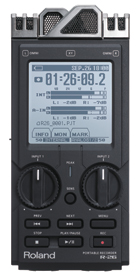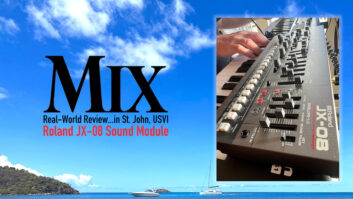
I recently had the opportunity to engineer some interesting field recordings. The first was at the Arizona Railway Museum recording train sounds to be used for a new toy train from Lionel. The other was to record sounds for a stop-motion short for director Trevvor Riley in various large, abandoned spaces. In each case the client specifically wanted clean, direct sound recordings of specific elements, but also wanted to capture the context of the recording environment. Armed with a trio of slick, new handheld recorders from Roland, Tascam and Nagra, I was able to simultaneously record ambience and spot mics with great results.
The Roland R-26 and Tascam DR-40 really shined in their ability to record using a combination of onboard stereo mics, while also offering phantom-powered XLR inputs. The Nagra SD came in handy by offering a variety of high-performance modular microphones that could be attached to a tiny, lightweight unit. Coupled with Rycote’s Portable Recorder Kit, providing a shock-mounted pistol grip and fur windmuff, the Nagra SD became the perfect tool for moving, fast-to-follow action.
ROLAND R-26
In terms of features for the price, the Roland R-26 is astounding. The device includes four miniature electret condenser microphones. Two of them employ cardioid pickup patterns and are arrayed in an X-Y configuration. The other two are a widely spaced pair of omni-directional pickups. In addition, XLR/TRS combo jacks can be used to receive signals from dynamic microphones, phantom-powered condenser microphones or line-level signals. Alternatively, a 1/8-inch stereo miniature jack can be used for external input. At sample rates ranging from 44.1 kHz/16-bit all the way to 96 kHz/24-bit, six-channel recordings with all four internal mics plus a stereo input are possible.

The build quality of the R-26 is sturdy. The large LCD touchscreen offers an onboard graphic waveform editor, allowing trims and fades to be performed in a way that will be pleasantly familiar to DAW users. The smooth rotating controls allowed me to make adjustments during recording without noticeable noise being picked up. Other features include a 1/8-inch mini jack for headphones, a built-in speaker, an SDHC card slot, and a 4-pin miniature B-Type USB connector, which can be used for transfers or to make the R-26 an interface. Using the included drivers, the R-26 acts as an I/O device compatible with Pro Tools 9, PreSonus StudioOne, Nuendo, Apple Logic and most other popular DAWs. A copy of SONAR LE is included.
I was truly impressed by the quality of the recorded sounds when using the onboard mics. Whether the low-end resonance of a train horn or the low-frequency waveforms that developed when stomping in an empty warehouse, the bottom end was excellent. The mic pre’s also worked very well with external mics.
I did a shootout sourcing a vocal through an Audio-Technica AT4071a into the R-26 pre’s, the DR-40 pre’s, and through a Sound Devices USBPre2 connected to the analog inputs of the R-26, and then the DR-40. The Sound Devices took the win, sounding remarkable through the A/D converters on either unit. The R-26 performed relatively similarly in the low to low-mid frequency range, however losing a slight amount of detail and sounding a bit muffled in the upper midrange. The DR-40 lost some low-end, performed respectably in the upper-midrange, but in the highest frequencies displayed a slightly “digital-sounding” garbling seeming to be the result of clocking and A/D inaccuracies. Also, in the top end, each device had varying degrees of slight hissy noise, but it seemed most pronounced in the R-26. When recording something as loud as a train, this was not noticeable at all. When recording nature ambience, this was apparent in recordings from both the built-in mics and the mic pre’s. Regardless, I still found the overall character of the analog front end to be superior in tonal quality to the DR-40, and in all ways preferable to what I’ve heard from the Zoom H4n.
Especially for the price, the analog front end was more than useable. With a rugged, professional look and feel, audio interface option, impressive sound quality and a mile-long list of features, the R-26 could easily sell at a much higher price tag. Given its retail price under $500, I could see the R-26 becoming a go-to recorder for serious professionals.


Tascam DR-40 Linear PCM Recorder
TASCAM DR-40
Tascam’s DR-40 has stepped up as the least expensive ($199) XLR-input recorder on the market. It doesn’t have all of the bells and whistles of the higher-priced recorders, but offers features that allow it do almost everything you need at a reasonable price. The onboard pair of electret mics can be adjusted between X-Y and A-B (wide stereo capture) recording configurations. The XLR inputs can receive dynamic mics or phantom-powered condensers, or can be switched to easily receive line-level signals. Up to four tracks can be recorded simultaneously, always resulting in stereo files. Naturally, the four tracks can be used to capture a combination of the two built-in mics plus signal from the XLR inputs. Skipping two of those inputs frees up two tracks, which can then be used to redundantly record a single pair of inputs at a lower level, providing a safety copy.
When close miking a train engine with an SM57, the DR-40 got the job done without coming up short. Recording voice with phantom power engaged, there was a cyclical, intermittent, high-frequency whining sitting deep beneath the track. This was absent when using an external mic pre, suggesting that there was some sort of electronic bleed creeping into the low-level-input microphone signals. That said, I was pleasantly surprised with the sound of the onboard mics. For the size and price of the capsules, the amount of low-frequency pickup and clarity in the top-end was impressive. Concert recordings were true-to-life. The stereo imaging on music as well as sound effect recordings reads really well. The ability to pan a mono spot mic up the middle while using the onboard stereo mics was really helpful. The panned and leveled mix of the four tracks could also be mixed down to a new stereo file within the DR-40. M/S decoders were common on all of the recorders reviewed. However, it was nice that the DR-40 would allow monitoring through the decoder using its variable-width option, and then print the result if desired. The headphone output was weak, especially when working in close proximity to the sound source; it was often difficult to hear the recorder’s output over the actual sound traveling through air. Moreover, the plastic body and noisy buttons made this the recorder most subject to handling noise. But all in all, this is a great little unit for under $200.


Nagra-SD
NAGRA SD
Anyone familiar with field recording knows the name Nagra. The Nagra SD is barely larger than a cigarette pack and constructed from sturdy aluminum. The back panel is covered in switches, and the face features a small display screen and various level, transport, and menu buttons. On one side is a headphone jack and the SD card slot, on the other is a miniature B-Type 4-pin USB connector for data transfers. The narrow top surface features a pair of 1/8-inch mini jacks designed to connect to the different clip-on input options; they can also directly receive mic or line-level signals.
All clip-on mics and cables are sold separately, but offerings include a mono, cardioid microphone; a dual-capsule stereo mic; a high-quality dual-capsule stereo mic; an omni mic; a stereo mic cable with dual XLRs; and a line-level stereo cable that terminates to dual XLRs. Neither of the microphone cables offers phantom power, so external mics requiring phantom power demand an external power supply. Accessories from Nagra’s ARES-M/MII/ML recorders are also compatible with the Nagra SD.
I spent the most time using the omni mic (marked with a blue band) and the high-quality stereo capsule (marked with a green band), which impressed me the most. The low midrange frequencies were very clear and detailed with great bottom and smooth, as well as balanced upper midrange and excellent top-end detail. As a result, I achieved an incredibly visceral image.
I was confused by the decision-making on the physical design. Certain features were given dedicated hardware switches that might have been as easily assigned to menu selections and vice versa. The unit included a protective carrying case with a tripod-style mount, which kept handling noise out of the recording. The case, however, blocked access to all of the back panel switches such as the mic-gain high/low toggle and the HPF—switches that I often needed to engage on the fly. De-casing required disconnecting headphones, making the process rather awkward. Similarly, pressing buttons through the clear, plastic top face of the case often caused errors, as two buttons would inadvertently be depressed at once.
The menu system was often difficult to navigate. For example, when you are four layers deep in a menu, it would be beneficial if the menu button brought you back to the top; instead, you have to scroll and navigate your way back home. Also, choosing whether you want to record a stereo or mono file should be a menu option, not a hardware switch. And for that matter, if I can’t get to the switches without taking off the case, I’d just as soon use the menus to gain access to them.
That said, you’d be hard-pressed to find another light, portable all-in-one recorder that sounds as good as this one. I think that Nagra envisioned the SD for broadcasters doing on-the-fly interviews, as that seems to be the connotation in the instruction manual. Given the microphone choices and portability, the unit seems more than capable of doing just that. With a little more ergonomic functionality, however, the SD could easily dominate the high end of the handheld recording market.
Brandon T. Hickey is a freelance engineer and audio educator.








